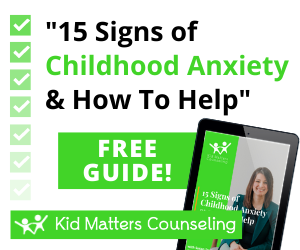Have you noticed lately that your child is having difficulty calming down when they get upset? Their tantrum lasts minutes, a half hour or even a whole hour! It seems that their emotions are getting so big that they are unable to rationalize or reason about why they are this unhappy. You want to help them and make sure they are safe, but right now you are feeling stuck.
It is important to remember that when children get upset, they aren’t able to use their rational and logical part of the brain, so they might not be able to tell you why they feel upset. Helping them get to a calmer place so that they can think more clearly will be beneficial for both you and your child.
Here are some coping tools to help your child calm down when they are feeling upset.
Tool Number 1: Take Deep Breaths
We all could use some deep breaths to regulate ourselves in these intense moments! Deep breathing sends messages to our brain to calm down. One way that you can introduce deep breathing is to make it relevant to things your child likes. For example, you might tell your child to “smell the flowers” or “smell the yummy pizza” and then to “blow the bubbles” or “blow out the birthday candles.”
Tool Number 2: Make Some Music
Do you remember when you used to rock your baby and hum or sing a song to them to help calm them down? Rhythm is extremely regulating for children, even when they aren’t babies anymore. When your child is having a hard time calming down, sitting with them humming their favorite song or any slow and rhythmic song can help them reset.
Tool Number 3: Become Mindful to the Present Moment with 5-4-3-2-1
Dependent on your child’s age, this mindfulness exercise can be helpful in distracting from intense emotions and helping them come back to the present moment. You simply name 5 things you can SEE, 4 things you can FEEL, 3 things you can HEAR, 2 things you can SMELL, and 1 think you can TASTE. You can even do this together so that your child feels safe and not alone in this overwhelming moment.
Tool Number 4: Take a break
Sometimes your child might just need a safe place to cool down on their own. After validating their emotions and telling them that you are there for them when they are ready, find a place for them to take a little space to calm down from the situation at hand.
Tool Number 5: Providing Sensory Input (Giving a Big Hug, Putting on Weighted Blanket, Taking a Shower)
Some kiddos find sensory input to be extremely regulating. A couple of examples of sensory input as a coping tool include, giving your child a big bear hug, putting a weighted blanket on your child, or having your child take a hot shower. These can be helpful in calming your child down in the moment.
So those are my five tips for helping your child calm down when they are feeling upset.
For more parenting tips on managing your child’s anxiety or anger be sure to subscribe to our free parenting newsletter, Parent Matters, where we help you raise safe and informed children.
Don’t parent alone.

Shana Sanchez
Child Therapist
I help children and families navigate trauma, transitions, and other mental health needs. My goal is to bring about meaningful change for both you and your child.
Kid Matters Counseling has trained therapists ready to help both kids and parents walk through the tough moments in life.
End the frustration & the confusion and let's work together! SCHEDULE APPOINTMENTNew Clients Call: (855) 586-1802
Current Clients: (855) 543-7687
Ask Us Anything!
We help anxious kids and frustrated parents. We serve Hinsdale & the Western Suburbs of Chicago.
Made with ♥︎ in Hinsdale, Illinois for Chicago
Built By Brand Your Practice.
Kid Matters Counseling, P.C. DISCLAIMER: This website and blog are for informational, educational and general discussion purposes only. It is understood that no guarantee or warranty arises from the information provided, discussed or commented upon in this website and blog nor does it constitute legal or other professional advice on any subject matter. Access to this website and blog is voluntary and at the sole risk of the user. If you think that you have a medical emergency (including clinical), call your doctor or 911 immediately. A licensed medical professional should be consulted for diagnosis and treatment of any and all medical conditions. While the information contained within this website and blog is periodically updated, no guarantee is given that the information provided is correct, complete, and/or up-to-date. See our complete Privacy Policy and Terms of Service.



